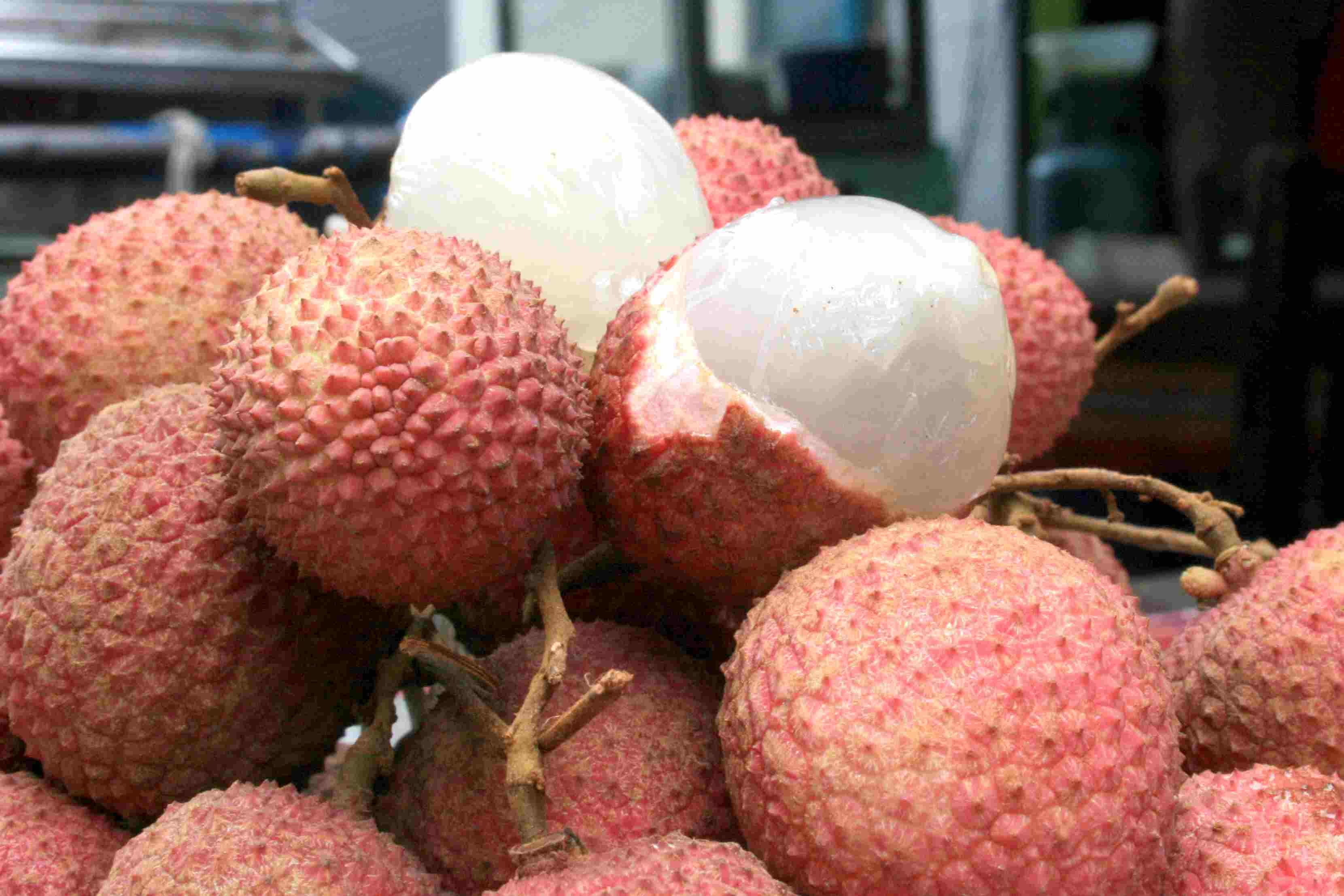
The outside of lychee is covered by a pink-red, roughly textured rind that is inedible but easily removed. Lychee is eaten in many different dessert dishes. The inside consists of a layer of sweet, translucent white flesh, rich in vitamin C, with a texture somewhat similar to that of a grape only much less moist. The edible flesh consists of a highly developed aril enveloping the seed. The center contains a single glossy brown nut-like seed. A major early Chinese historical reference to lychees was made in the Tang Dynasty, when it was the favorite fruit of Emperor Li Longji (Xuanzong)'s favored concubine Yang Yuhuan (Yang Guifei). The emperor had the fruit, which was only grown in southern China, delivered by the imperial messenger service's fast horses, whose riders would take shifts day and night in a Pony Express-like manner, to the capital. (Most historians believe the fruits were delivered from modern Guangdong, but some believe they came from modern Sichuan.)
Lychee (Litchi chinensis) is a tropical and subtropical fruit tree which belongs to the soapberry family. It is native to Southeast Asia and is mainly cultivated in China, India, Thailand, Vietnam, and Taiwan. The fruit has a sweet and delicate taste and is popular worldwide for its juicy flesh and aromatic fragrance. In this article, we will discuss the history, cultivation, health benefits, and culinary uses of lychee.
Lychee has a long and illustrious history. The fruit was first cultivated in China more than 2,000 years ago and was prized by Chinese emperors for its delicious taste and health benefits. The first record of lychee dates back to the Tang Dynasty (618-907 AD) when the fruit was known as 'Lizhi'. It was considered a delicacy and was often given as a gift to other countries. In the 17th century, lychee was introduced to Europe by Dutch traders and it became popular in the royal courts of France and England.
Lychee is a tropical and subtropical fruit tree that prefers warm, humid conditions. It grows best in well-drained soils with pH levels between 5.0 to 7.5. The tree can reach up to 40 feet in height and produces clusters of small, white, fragrant flowers in the spring. The flowers are followed by fleshy fruits that are oval or heart-shaped and covered with a rough, red or pink skin. The fruit contains a single large seed and is typically harvested in the summer.
Lychees are primarily hand-harvested, and the fruit is highly perishable. After harvesting, the lychees are usually placed in plastic bags or trays and stored at a cool temperature of around 32 to 40 F and high humidity to prolong their shelf life.
Lychee has many health benefits. The fruit is low in calories and fat and is a good source of dietary fiber, Vitamin C, Vitamins B-complex, potassium, and copper. The following are some health benefits of lychee.
1. Boosts Immunity: Lychee is packed with Vitamin C which is essential for boosting immunity. It helps in increasing the production of white blood cells that fight against infections and diseases.
2. Improves Digestion: The fiber content of lychee helps in promoting a healthy digestive system. It also helps in improving digestion by ensuring that nutrients in food are absorbed properly.
3. Good for Heart Health: Lychee is a great source of potassium which helps in maintaining a healthy heart. It enables the muscles to contract and relax properly and regulates blood pressure.
4. Improves Blood Circulation: Lychee contains iron which is essential for the production of red blood cells. It improves blood circulation and prevents the development of anemic conditions.
Lychee is used in many culinary preparations worldwide. It is a popular ingredient in desserts, drinks, and savory dishes. Here are some culinary uses of lychee.
1. Juice: Lychee juice is a popular beverage worldwide. It is made by extracting the juice from fresh lychees and adding sugar and water.
2. Cocktails: Lychee is often used in cocktails and mocktails. The fruit's delicate flavor pairs well with gin, vodka, and other spirits.
3. Ice Cream: Lychee is a popular flavor in ice cream. The fruit's sweet and fragrant flavor is a perfect complement to the creamy texture of ice cream.
4. Soups: Lychee is used in soups in southern China's Guangdong province. It adds a sweet and sour flavor to the soup and is often served as a refreshing summer dish.
More About Lychee
Lychee is a delicious and healthy fruit with a long and rich history. It has a wide range of culinary uses and is enjoyed worldwide in desserts, drinks, and savory dishes. Apart from its irresistible taste, lychee is also rich in nutrients that are essential for maintaining good health. Whether you eat it fresh, canned, or in a dessert, lychee is a fruit that you should try at least once in your lifetime.